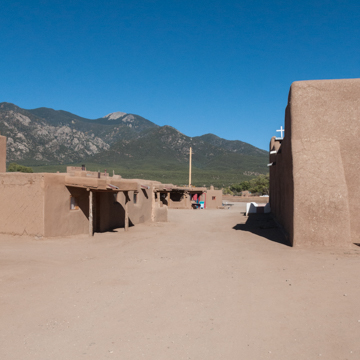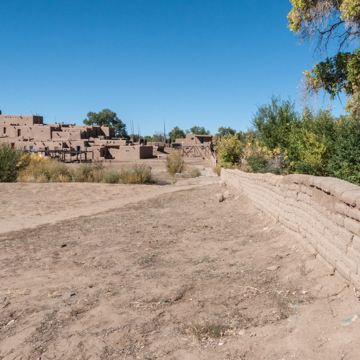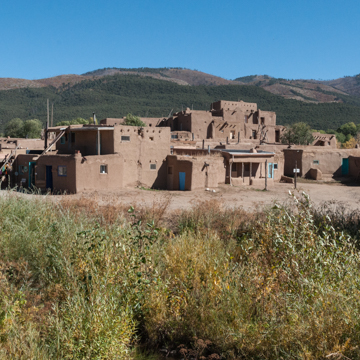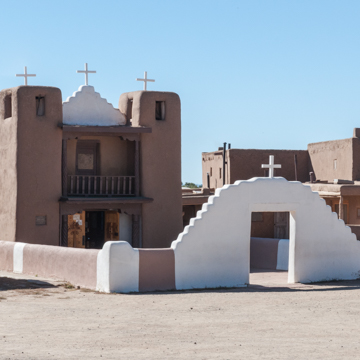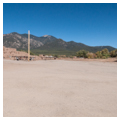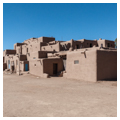Taos Pueblo is one of the most iconic sites in the entire American Southwest. Though the pueblo stands immediately to the north of modern Taos and is now reached by automobile along a paved highway, it nonetheless seems to stand apart in an unchanging time and space. Designated a Living World Heritage Site by UNESCO, the pueblo maintains an ancestral way of life grounded in the cyclical order of earth, sky, and seasons. Its apparent timelessness has made Taos a recurring source of fascination to visitors, who find in the pueblo’s harmonious sense of place an antidote to the frenetic alienation of modern society. Yet this place is neither as fixed nor as simple as its coherence suggests. The pueblo is an ancient crossroads, with a long history of negotiating the challenges brought by the outside world.
Settlement in Taos Valley dates to 1000–1200. The first dwellings were circular pit houses built partly below ground. Unit pueblos, rectangular dwellings built from additive units, began to replace the pit dwellings around 1200–1250. After 1250, these unit pueblos were aggregated into larger, multistory pueblos that included kivas, communal spaces perhaps derived from pit houses. Cornfield Pueblo, the immediate predecessor to Taos Pueblo, was built and occupied circa 1325–1400. Construction of the present pueblo began to the west of Cornfield Pueblo circa 1400 and continues to this day.
The ancestors of Taos are believed to include both Chacoan peoples and Plains Indians. The pueblo belongs to the Northern Tiwa group in the Tanoan family of languages. Its name, Taos, is probably a Spanish corruption of the Tiwa word for village, tə̂o; the pueblo’s Tiwa name of ȉałopháybo means “at (the place of) the Red Willows.” Taos is sited along Red Willow Creek (Taos River), whose waters flow from Blue Lake in Taos Mountain, the lobed and terraced peak that rises dramatically behind the pueblo to the northeast. Blue Lake and Taos Mountain are sacred to the pueblo, and the site of an annual pilgrimage every August.
Written descriptions of the pueblo from the sixteenth to eighteenth centuries record a layout that has persisted for centuries and remains much the same today. The community says of itself, “We are in one nest,” capturing how the pueblo is held within a perimeter wall and centered on a plaza. Once taller and punctuated by fortified towers, the wall protected the pueblo against Comanche and Ute raids until they were pacified during the nineteenth century. Since then, the wall has shed its defensive role and height without losing its essential purpose of circumscribing and marking off this place within the larger realm of nature.
The vast, slightly concave plaza, which seems to cup the sky on its earthen floor, is oriented east-to-west with Taos Mountain behind, and traversed by Red Willow Creek. The plaza is at once sacred ground and a stage for daily life in the pueblo. Ceremonial dances take place here, as well as long-distance relay races run in May and September. Called the Sun Road, the unmarked racetrack extends beyond the plaza through a break in the eastern boundary wall and represents the sun’s celestial power and course. The wooden racks ( ramadas) along the plaza’s north side were built for practical chores like drying crops and meats but are regularly repurposed as booths to exchange goods during seasonal fairs. These have made the pueblo an historic locus of trade, initially between Plains Indians coming from the north and the Rio Grande pueblos to the south, joined later by Spaniards and Americans.
Housing blocks frame the plaza and creek to the north and south. Assembled from multiple dwellings, these meander in winding ranges crossed by alleys as they ascend and descend between one and five stories in height. The elongated North House, its stepped profile set memorably against Taos Mountain, climbs to five stories at its highest point, while the more diffuse South House swells to four against the lower hills to the south. Interior plazas, folded into the rear of housing blocks, cradle clusters of kivas. These circular, subterranean structures are protected by palisades of poles and entered through the roof by tall ladders whose uprights reach to the sky. Children of both sexes are allied with the kivas at birth, and they are the foundation to the pueblo’s social organization.
Despite the geometric clarity of its massing, the pueblo is the result of an organic continuum of growth and decay, determined by circumstance and evolving needs rather than any master plan. Adobe walls (originally puddled, later molded brick) are finished with clay plaster and support roofs built up from pine beams, saplings or split logs, reeds or grasses, and a covering of packed earth. Because the housing blocks are composed from cellular units that are structurally as well as spatially independent of each other, either additions to or subtractions from the larger complex are accommodated flexibly in an open-ended process of construction.
The form of Taos is therefore remarkably consistent yet in a state of constant if incremental metamorphosis. Until the later nineteenth century, when its architecture became less defensive, there were no doorways in the housing blocks. The blocks were entered by ladders through the roofs above; the few windows were small and glazed with mica. The roofs functioned as floors for outdoor rooms, many with ramadas like those found in the plaza below. Factory-made doors became available in the 1890s, and the use of sash windows and glass panes was first allowed in the 1930s. As both began to punctuate the housing blocks, the earlier means of entry and circulation shifted from the vertical to horizontal plane, and the previously closed elevations were refashioned into the modern pattern of solids and voids one sees today.
Many of the greatest changes experienced by the pueblo arrived from the outside. A scouting party from Francisco Vázquez de Coronado’s exploratory expedition to the Southwest visited Taos in 1541. In 1598, the provincial governor of New Mexico, Juan de Oñate, sent a Franciscan friar, Fray Francisco de Zamora, to convert the pueblo and establish the mission of San Geronimo (San Jéronimo). Fray Tomás Carrasco built the first mission church and friary ( convento) circa 1617–1627. These were located within the perimeter wall, yet outside and to the northwest of the pueblo proper, alongside the houses of Spanish colonists who had settled on its fringes in the 1620s.
Besides converting the Indians, the missionaries institutionalized the pueblo’s annual trade fair as the Feast Day of San Geronimo on September 30 of each year. Relations between the Indians and Spaniards would be marked by a history of resistance, both to Catholicism and to the encomienda, the tax of cloth, grain, and labor that the colonizers levied on the pueblos. In 1639, Taos rose up, killed its resident friar, and destroyed the church. The friars returned and rebuilt the church circa 1660, but it was destroyed again in the Pueblo Revolt of 1680–1692. Led from Taos by Popé, a medicine man from San Juan Pueblo (Ohkay Owingeh) to the south, the revolt was suppressed in 1692–1693 by the returning Spaniards under Diego de Vargas, the provincial governor. Taos Pueblo continued to resist and only submitted after Vargas returned twice to quell opposition in 1694 and 1696.
Friction yielded to greater cooperation in the face of raids by the Comanche and Ute Indians who terrorized New Mexico in the eighteenth century. Circa 1702–1712, Fray Juan de Mirabal rebuilt the mission of San Geronimo. The church had a single, buttressed tower at the southwest corner of its south-facing facade, and a raised parapet with embrasures around the roof. The single nave had a transept clerestory and a choir loft with a window, but only two small windows in its east wall alongside the friary ( convento).
Until the nineteenth century, this church served both the Native American pueblo and the Spanish village of Fernández de Taos (modern Taos) to the west. It was destroyed in 1847 by artillery shelling during the Mexican-American War of 1846–1848. The Hispanic residents of Fernández de Taos had retreated to the mission after some 500 U.S. Army soldiers were sent from Santa Fe to put down their rebellion against the American occupation. Though the adobe walls of the ruined church are mostly gone, the eroded mass of its fortified tower remains standing.
Around 1850, a new church of San Geronimo was built of adobe and timber on the western edge of the pueblo’s main plaza. The single-nave church has a transverse clerestory but no transepts. Fronted by a small, walled cemetery ( camposanto) with a stepped entrance gate, it initially had a simple, low facade without towers and only a stepped bell cote over the church portal. At some point between 1939 and 1962, San Geronimo was remodeled to its present form along the lines of San José at Las Trampas. The east end of the nave was stepped up to make space for a choir loft, and a choir loft porch and window with flanking towers were added to the facade.
San Geronimo’s relocation, from a place that was physically and symbolically peripheral to the pueblo, to one that is apparently central, approximates the siting of many parish churches in New Mexico’s Hispanic towns and villages. This move breaks with the example of most pueblos, whose mission churches typically stand apart, and suggests that Taos finally came to terms with the Catholic Church after centuries of mistrust. And yet, as both Vincent Scully and Marc Treib have noticed, the scale and placement of San Geronimo inverts the expected hierarchies: instead of dominating, the church is subordinate to the pueblo and its plaza.
Even with the added towers, the church remains diminutive. It reads less like a monument than as a continuation of the surrounding housing blocks that act collectively to frame the plaza. The nave, which is small and cozy rather than grand and imposing, corroborates this domestic sense and turns San Geronimo with its stepped entrance gate into a threshold, a place to step away from the plaza’s great public space. Tacitly, the Christian church and Native American plaza are juxtaposed as two very different if complementary sacred realms. Where San Geronimo retreats inward to a spiritual world set apart from the nature, the plaza radiates outward, embracing the natural world and collecting its spiritual power for the pueblo.
Taos has learned to accommodate change while preserving its beliefs, customs, and identity. The arrival of the railroad in New Mexico in 1879–1880 introduced a modern cash economy that undermined the pueblo’s agrarian subsistence and barter economy. Taking advantage of the “Indian Detours” that were launched in 1926 by the Fred Harvey Company in partnership with the Atchison, Topeka and Santa Fe Railroad, the pueblo became the major tourist destination it has been ever since. Yet the Indian Reorganization (or Wheeler-Howard) Act of 1934 reversed the goal of assimilation by encouraging Native Americans to preserve their cultures. In 1970, when President Nixon signed Public Law 91-550, Taos Pueblo regained possession of Blue Lake and 48,000 acres of sacred land that it had lost to the federal government in 1906. Access to the Blue Lake Wilderness Area is now restricted to the pueblo.
Taos Pueblo turns a welcoming face to visitors, and guards its traditions. Except on specific occasions like the San Geronimo Feast Day, its ceremonies are closed to the public, and its language, religious practices, and kivas are all strictly reserved for tribal members.
References
Adams, Eleanor, and Fray Angelico Chavez. The Missions of New Mexico, 1776: A Description by Fray Francisco Atanasio Domínguez with Other Contemporary Documents. Albuquerque: University of New Mexico Press, 1956.
Boyer, Jeffrey, “Taos Pueblo,” Taos County, New Mexico. National Register of Historic Places Inventory–Nomination Form, 1985. National Park Service, U.S. Department of the Interior, Washington, D.C.
Bunting, Bainbridge. Early Architecture in New Mexico. Albuquerque: University of New Mexico Press, 1976.
Cordell, Linda. Archaeology of the Southwest. 2nd ed. San Diego, CA: Academic Press, 1997.
Dutton, Bertha P. American Indians of the Southwest. Revised and enlarged edition. Albuquerque: University of New Mexico Press, 1983.
Jackson, John Brinkerhoff. “Pueblo Dwellings and Our Own.” In A Sense of Place, A Sense of Time. New Haven: Yale University Press, 1994.
Kessel, John L. The Missions of New Mexico Since 1776. Albuquerque: University of New Mexico Press, 1980.
Kubler, George. The Religious Architecture of New Mexico In the Colonial Period and Since the American Occupation. 1940. Reprint, Albuquerque: University of New Mexico Press, 1972.
Luhan, Mable Dodge. Winter in Taos. Denver: Sage Books, 1935.
Nabokov, Peter, and Robert Easton. Native American Architecture. New York: Oxford University Press, 1989.
Ortiz, Alfonso, ed. Handbook of North American Indians: Southwest. Washington, D.C.: Smithsonian Institution, 1979.
Scully, Vincent. Pueblo: Village, Mountain, Dance. New York: Viking Press, 1972.
Treib, Marc. Sanctuaries of Spanish New Mexico. Berkeley: University of California Press, 1993.












